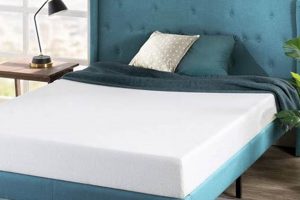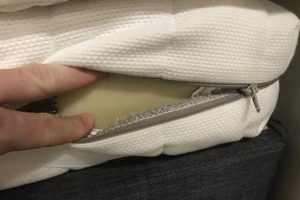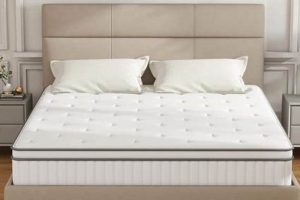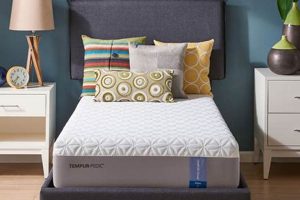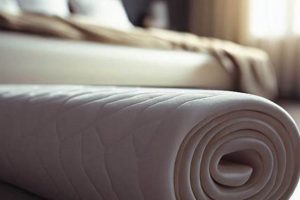These sleep surfaces combine viscoelastic foam with an integrated cooling agent, typically a gel infused into the foam matrix. The purpose of this design is to mitigate the heat retention properties often associated with traditional memory foam, offering a more temperature-neutral sleep experience. The gel component works to absorb and dissipate body heat, helping to regulate the sleeper’s temperature throughout the night.
The development of these mattresses addresses a common complaint about conventional memory foam: its tendency to trap heat, leading to discomfort and disrupted sleep. By incorporating cooling technologies, manufacturers aim to provide the conforming support and pressure relief of memory foam without the drawbacks of excessive warmth. This approach has gained traction due to the increasing awareness of the impact of sleep temperature on overall sleep quality and well-being.
The following sections will delve into the specific types of cooling gels used, the construction methods that enhance cooling performance, and the key factors to consider when selecting a mattress designed to regulate temperature during sleep.
Selecting a Temperature-Regulating Sleep Surface
The following guidelines provide insights into choosing a mattress designed to minimize heat retention and promote a cooler sleep environment.
Tip 1: Prioritize Gel Infusion Density: Mattresses with a higher concentration of gel particles within the memory foam tend to offer superior cooling capabilities. Examine product specifications for details regarding gel infusion density or seek confirmation from the manufacturer.
Tip 2: Consider Open-Cell Foam Construction: Opt for mattresses that utilize open-cell memory foam. This structure promotes enhanced airflow compared to traditional closed-cell foam, aiding in heat dissipation and reducing the risk of overheating.
Tip 3: Evaluate the Mattress Cover Material: The cover material plays a crucial role in regulating temperature. Look for covers made from breathable fabrics such as Tencel or cotton, which facilitate airflow and wick away moisture, contributing to a cooler sleep surface.
Tip 4: Research Independent Testing and Reviews: Before making a purchase, research independent testing data and customer reviews. These resources can provide valuable insights into the real-world cooling performance and durability of specific mattress models.
Tip 5: Assess the Mattress’s Overall Construction: Examine the overall construction of the mattress, including the presence of ventilation channels or other cooling technologies. These design features can further enhance airflow and improve temperature regulation.
Tip 6: Check the ILD Rating: The Indentation Load Deflection (ILD) rating indicates the firmness of the foam. A lower ILD rating generally results in a softer feel, which may allow for more body sinking and potentially less airflow. Consider a slightly firmer option for improved breathability.
Understanding these factors can significantly improve the likelihood of selecting a mattress that effectively manages sleep temperature, leading to a more restful and comfortable sleep experience.
The subsequent sections will address the maintenance and care requirements for this type of sleep surface, ensuring optimal performance and longevity.
1. Gel Infusion Density
Gel infusion density is a critical determinant of the cooling effectiveness within memory foam mattresses. It dictates the extent to which the mattress can absorb and dissipate heat, directly influencing the sleeper’s thermal comfort. The concentration of gel particles distributed throughout the memory foam matrix is directly proportional to the mattress’s ability to regulate temperature.
- Heat Absorption Capacity
A higher gel infusion density translates to a greater capacity for absorbing body heat. The gel particles act as a thermal reservoir, drawing heat away from the sleeper. For instance, a mattress with a high-density gel infusion will feel cooler to the touch upon initial contact and will maintain a more consistent temperature throughout the night compared to a mattress with lower gel density.
- Thermal Conductivity
Increased gel infusion density enhances the overall thermal conductivity of the memory foam. This facilitates the efficient transfer of heat away from the sleeper and towards the surrounding environment. Examples of implementation include improved comfort and reduced overheating.
- Longevity of Cooling Effect
A denser gel infusion typically leads to a more prolonged cooling effect. The greater volume of gel particles allows for a more gradual saturation with heat, extending the time before the mattress reaches an uncomfortable temperature. This is crucial for individuals who tend to sleep hot, as it minimizes fluctuations in temperature throughout the night.
- Impact on Mattress Firmness
Gel infusion density can influence the firmness of the memory foam. Higher density infusions may slightly alter the compression modulus of the foam, potentially resulting in a firmer feel. Manufacturers must carefully balance the gel concentration to achieve the desired cooling performance without compromising the comfort and support characteristics of the mattress.
Ultimately, gel infusion density is a key performance indicator for temperature regulation. Selecting a cooling gel memory foam mattress with a high gel infusion density maximizes the potential for achieving a comfortable and undisturbed sleep experience, particularly for those sensitive to sleeping hot. The optimization of gel density with other cooling technologies ensures a balanced and effective approach to temperature management.
2. Open-Cell Structure
Open-cell structure within foam materials significantly impacts the thermal properties of a cooling gel memory foam mattress. Traditional memory foam, characterized by a closed-cell structure, impedes airflow, leading to heat retention. Open-cell foam, conversely, features interconnected cells that facilitate air circulation. This allows for the dissipation of body heat away from the sleeper, mitigating the heat buildup associated with conventional memory foam. The incorporation of open-cell technology is, therefore, a crucial element in achieving the desired cooling effect in these mattresses.
The effectiveness of the open-cell structure is further enhanced when combined with cooling gel infusions. The gel absorbs heat, while the open-cell structure provides a pathway for that heat to be carried away from the body. For instance, a mattress utilizing both high-density open-cell memory foam and a substantial gel infusion demonstrates improved temperature regulation compared to a mattress with only on
e of these features. In practical terms, this translates to a reduced likelihood of night sweats and a more stable sleep environment.
While open-cell structure enhances breathability, it also presents potential challenges. Open-cell foam may exhibit a slightly reduced density and support compared to closed-cell foam. Manufacturers address this by carefully calibrating the foam formulation and incorporating supportive base layers. Ultimately, the successful integration of open-cell structure within a cooling gel memory foam mattress represents a trade-off between enhanced cooling and maintaining adequate support and durability. The long-term performance depends on the material quality and construction techniques employed.
3. Breathable Cover Material
The outermost layer of a sleep surface, specifically a mattress, significantly influences temperature regulation and overall sleep comfort. In the context of a mattress engineered with cooling gel memory foam, the selection of a breathable cover material is paramount for maximizing the intended cooling benefits.
- Moisture Wicking Properties
Fabrics with effective moisture-wicking capabilities facilitate the evaporation of perspiration, preventing the accumulation of moisture against the skin. Materials such as Tencel, bamboo rayon, and certain performance knits actively draw moisture away from the body, promoting a drier and cooler sleep environment. The absence of moisture buildup minimizes humidity and enhances airflow, complementing the cooling action of the gel-infused memory foam.
- Air Permeability
Air permeability refers to the ability of a fabric to allow air to pass through it. Cover materials with a higher air permeability rating promote continuous air circulation around the sleeper, aiding in the dissipation of heat. Tightly woven fabrics restrict airflow, negating the cooling potential of the mattress core. Open weaves and knitted constructions generally exhibit superior air permeability, contributing to a more temperature-neutral sleep surface.
- Material Composition and Weave Structure
The fiber composition and weave structure of the cover material directly impact its breathability and thermal properties. Natural fibers like cotton and linen, known for their breathability, are often blended with synthetic fibers to enhance durability and moisture management. The weave structure, whether plain, twill, or knit, also influences airflow. Looser weaves generally offer better breathability than tighter weaves.
- Thermal Conductivity
The thermal conductivity of the cover material determines its ability to conduct heat away from the body. Fabrics with high thermal conductivity, such as certain types of linen, facilitate heat transfer, contributing to a cooler sleep surface. Conversely, materials with low thermal conductivity, such as synthetic blends with limited breathability, can trap heat, negating the intended cooling effects of the gel memory foam.
The selection of a breathable cover material represents a critical component in the overall design of a sleep surface aimed at regulating temperature. By optimizing moisture wicking, air permeability, material composition, and thermal conductivity, manufacturers can enhance the efficacy of cooling gel memory foam and provide a more comfortable and restorative sleep experience. The interplay between the cover material and the underlying cooling technologies is essential for achieving the desired thermal performance.
4. Ventilation Channels
Ventilation channels within a mattress, particularly those incorporating cooling gel memory foam, serve as a key mechanism for regulating temperature and enhancing airflow. These channels, strategically integrated into the foam layers, create pathways for heat to dissipate away from the sleeper’s body. The incorporation of ventilation channels directly addresses the inherent heat retention properties of viscoelastic foam, which, without such modifications, tends to trap body heat, leading to discomfort and disrupted sleep. A mattress lacking adequate ventilation channels may negate the cooling benefits of the gel infusion, rendering the technology less effective. For instance, a consumer may purchase a mattress described as having cooling capabilities, but if it lacks sufficient ventilation, the sleeper could still experience overheating. This highlights the vital role of these channels as a complementary feature.
The design and placement of ventilation channels vary across different mattress models. Some feature horizontal channels cut into the foam surface, while others utilize vertical channels or a combination of both. The effectiveness of these channels depends on factors such as their width, depth, density, and connection to the external environment. Mattresses with interconnected channel networks generally offer superior airflow compared to those with isolated channels. A practical example is found in high-end mattresses where intricate channel designs are combined with breathable cover materials to create a comprehensive cooling system. This careful engineering results in a noticeably cooler sleep surface, directly impacting sleep quality and duration. The construction of the ventilation channels is also a factor, some channels are made of flexible material, some are not, which allow the air to flow freely for all night long and maintain the mattress quality.
In summary, ventilation channels are an integral component of a mattress engineered for temperature regulation. They work synergistically with cooling gel infusions and breathable cover materials to create a more comfortable sleep environment. While the presence of cooling gel alone may offer some benefit, the addition of strategically designed ventilation channels significantly enhances the mattress’s ability to dissipate heat and maintain a consistent temperature throughout the night. The practical significance of this understanding lies in enabling consumers to make informed purchasing decisions, prioritizing mattresses with demonstrable ventilation features to maximize the potential for a restful and cool night’s sleep. A future improvements and advancement is to make a active ventilation channels that can adapt based on temperature.
5. Heat Dissipation
Heat dissipation represents a crucial performance parameter for any sleep surface designed to mitigate thermal discomfort. In the context of this sleep surface, the efficiency with which the mattress removes body heat directly influences the sleeper’s thermal comfort and overall sleep quality. The following facets explore the underlying mechanisms and influencing factors.
- Gel Matrix Conductivity
The thermal conductivity of the gel-infused memory foam dictates the rate at which heat is drawn away from the sleeper’s body. A higher thermal conductivity facilitates rapid heat transfer from the contact surface to the surrounding mattress layers, promoting a cooler sleep environment. For example, cooling gels with embedded phase-change materials can further enhance this process by absorbing heat and undergoing a phase transition, storing thermal energy
and maintaining a stable temperature. - Airflow Dynamics
Effective heat dissipation requires adequate airflow within the mattress structure. Ventilation channels, open-cell foam architecture, and breathable cover materials work in concert to promote air circulation, facilitating the removal of heat from the mattress core. Without sufficient airflow, heat can accumulate, negating the benefits of the cooling gel. Mattresses lacking these features may experience a localized increase in temperature, leading to thermal discomfort and disrupted sleep.
- Surface Area Maximization
Increasing the surface area available for heat exchange can enhance the rate of heat dissipation. Mattress designs incorporating convoluted foam surfaces or strategically placed perforations increase the contact area between the mattress and the surrounding air, promoting more efficient heat transfer. Such designs can be observed in higher-end mattresses that prioritize thermal regulation as a key performance characteristic.
- Moisture Management
The accumulation of moisture, primarily from perspiration, can impede heat dissipation and create a humid sleep environment. Moisture-wicking cover materials and breathable foam layers help to manage moisture levels, allowing for more efficient evaporative cooling. Mattresses that lack adequate moisture management features may become damp and uncomfortable, hindering the ability of the cooling gel to regulate temperature effectively.
These interconnected factors demonstrate the complexity of heat dissipation within a cooling gel memory foam mattress. Optimizing each of these aspects is essential for achieving the desired cooling performance and ensuring a comfortable and restorative sleep experience. The absence of any one of these features can compromise the overall effectiveness of the mattress in mitigating thermal discomfort.
6. Firmness Level
Firmness level is a key characteristic influencing perceived temperature and airflow within a mattress. It affects how deeply a sleeper sinks into the material, impacting the extent of body contact with the cooling gel and the efficiency of heat dissipation mechanisms.
- Impact on Airflow
A firmer mattress typically allows for greater airflow around the body compared to a softer one. When a sleeper sinks deeply into a soft mattress, less air circulates, potentially trapping heat. Conversely, a firmer surface maintains a more consistent airflow, facilitating heat dissipation and enhancing the effectiveness of any cooling features.
- Influence on Contact Area
Softer mattresses conform more closely to the body, increasing the surface area of contact. While this can enhance the feeling of pressure relief, it also reduces airflow and can limit the cooling effect of the gel infusion. Firmer mattresses, with less contouring, minimize contact area and promote greater airflow, but may compromise pressure relief for some individuals.
- Perception of Temperature
The subjective perception of temperature can be influenced by firmness. A softer mattress that conforms tightly may feel warmer due to reduced airflow and increased insulation. A firmer mattress, promoting airflow and minimizing contact, may feel cooler, even if the actual temperature difference is minimal.
- Material Compression and Heat Retention
Softer materials compress more under pressure, potentially increasing density and reducing airflow. This compression can lead to localized heat retention. Firmer materials resist compression, maintaining airflow and minimizing heat buildup. The long-term performance of a cooling gel memory foam mattress can be affected if it is too soft and subject to excessive compression over time.
Therefore, selecting an appropriate firmness level is critical for optimizing the cooling performance. A balance between comfort, support, and airflow is essential to maximize the benefits and create a comfortable sleep environment.
Frequently Asked Questions
The following addresses common inquiries concerning cooling gel memory foam mattresses, providing clear, factual responses to assist in informed decision-making.
Question 1: What is the expected lifespan of a cooling gel memory foam mattress?
The lifespan is typically between 7 to 10 years, contingent upon factors such as usage patterns, body weight, and maintenance practices. Regular rotation can contribute to extended longevity.
Question 2: Are these mattresses suitable for individuals with allergies?
The hypoallergenic properties vary based on the specific materials and manufacturing processes. Some mattresses incorporate hypoallergenic covers or antimicrobial treatments. Reviewing product specifications and certifications is advisable.
Question 3: Does the cooling effect diminish over time?
The efficacy of the cooling gel may gradually decrease over the lifespan of the mattress, particularly with consistent use and exposure to body heat. However, proper maintenance and the use of breathable bedding can help prolong the cooling effect.
Question 4: How does the firmness level affect the cooling performance?
Firmness level influences airflow and body contact with the cooling gel. Firmer mattresses generally promote better airflow, while softer mattresses conform more closely to the body, potentially reducing ventilation. The ideal firmness level is a matter of individual preference and sleep position.
Question 5: What type of foundation is recommended?
These mattresses are compatible with various foundation types, including platform beds, adjustable bases, and traditional box springs. Ensure the foundation provides adequate support and is in good condition to prevent premature wear or sagging.
Question 6: How should a cooling gel memory foam mattress be cleaned?
Spot cleaning with a mild detergent and water is generally recommended. Avoid harsh chemicals or excessive moisture, which can damage the foam. A mattress protector can help prevent stains and maintain hygiene.
The information provided aims to clarify common concerns and misconceptions surrounding these mattresses. Further research and consultation with sleep specialists are encouraged for personalized recommendations.
The subsequent sections will explore the impact of environmental factors on the performance and longevity of these mattresses.
Cooling Gel Memory Foam Mattress
This exploration has illuminated the multifaceted nature of the cooling gel memory foam mattress. Key elements, including gel infusion density, open-cell structure, breathable cover materials, ventilation channels, and firmness level, collectively determine its thermal performance. Optimal cooling is achieved through a synergistic interplay of these design aspects, maximizing heat dissipation and promoting a comfortable sleep environment.
The continued development and refinement of cooling technologies within sleep surfaces remain crucial for addressing the pervasive issue of sleep temperature regulation. Prudent evaluation of product specifications, coupled with an understanding of the underlying mechanisms, empowers consumers to make informed choices, ultimately fostering improved sleep quality and overall well-being.


